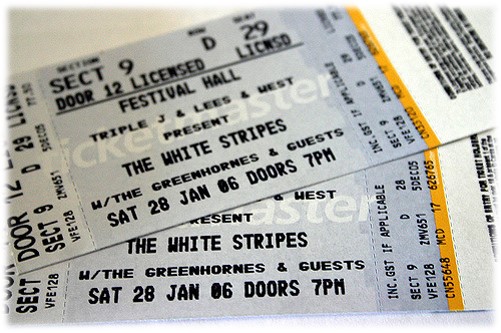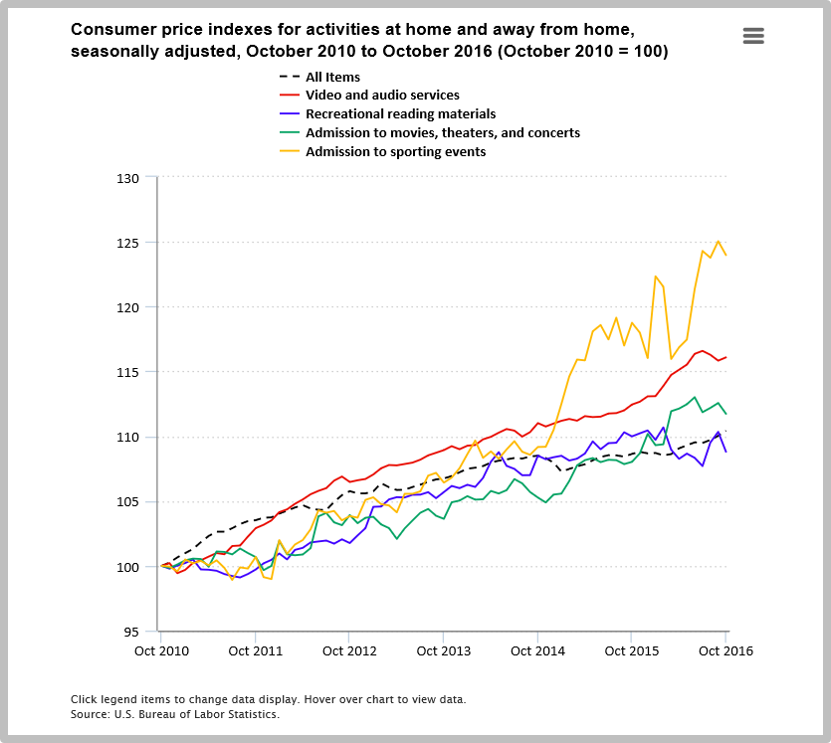
One of the odd dynamics of the U.S. economy these past several years is that inflation continues to be very, very low. Mortgages are cheap, you get a car loan with a low percentage rate, and leaving your money in a savings account generates virtually no income.
But when it comes to entertainment, it’s an entirely different story. The U.S. Bureau of Labor Statistics has released new data based on the Consumer Price Index that bucks that trend. It shows the cost of most forms of entertainment continues to rise – at a rate well above inflation.
 Overall, the cost of all the different entertainment outlets (the black hash line) on the chart has gone up more than 10% since 2010. And as you can see, a number of entertainment pastimes are not just getting more expensive, their costs are have been sharply rising over the past six years.
Overall, the cost of all the different entertainment outlets (the black hash line) on the chart has gone up more than 10% since 2010. And as you can see, a number of entertainment pastimes are not just getting more expensive, their costs are have been sharply rising over the past six years.
The price of attending a movie, the theater, or a concert has risen more than 11%, while sporting events have exploded – up 24% during the past six years.
And in a sector near and dear to those of us in radio, the cost of video and audio services has also been on the rise, moving up 16% from 2010-2016. It just keeps getting more expensive for consumers to entertain themselves with sight and sound.
Except for radio.
Because if there was a radio line on this chart, it would be flat-lined at 0%. While everything else in the entertainment world has gotten progressively more costly – even in these times of low inflation – radio remains the reliable, simple, and no-cost way for consumers to entertain and inform themselves.
And inside this chart is another reminder to radio programmers and marketers – something we hear every time we moderate focus groups and 1-on-1 interviews with listeners. While stations often strive to give away bigger than life items like cars or exotic vacations, a simple pair of tickets to a concert, festival, street fair, or local sporting event can be worth its weight in gold to a family faced with trying to keep up with the rising lines on this chart.
Leave it to the U.S. Bureau of Labor Statistics to create a compelling sales piece for radio, as well as a reminder to programmers about what moves the needle with the audience.
Radio: Simple, reliable, FREE.
You can check out this chart interactively by clicking here. Thanks to Bill Jacobs for connecting the dots.
- What To Do If Your Radio Station Goes Through A Midlife Crisis - April 25, 2025
- A 2020 Lesson?It Could All Be Gone In A Flash - April 24, 2025
- How AI Can Give Radio Personalities More…PERSONALITY - April 23, 2025




Fred:
Insightful as always. Thank you. I’d like to add a corollary, however.
The cost of entertainment has been rising rapidly, but so has the value that we get in return. Concerts feature ever-more over the top production, luxury seating, artist meet and greets, and VIP parking. TV is now an endless library of what is arguably the best content ever created, all on demand and available on every screen. The movie theater experience now includes oversized power-reclining seats, craft beer, and unbelievable food options. So, yes, the cost has gone up, but there seems to be a willingness to pay, so long as the value remains high.
In regard to radio I would argue that we keep the price low at the expense of user experience. Is the radio content we produce today the best it’s ever been? Is it as live, local, and relevant as it has to be to compete with all of the other choices out there?
Maybe we need a price increase!
Oh wait, we’re running more commercial inventory than ever before. Maybe we did increase the cost to our consumers. We just haven’t simultaneously improved the value proposition that we make to them.
John
I had a feeling someone very smart would challenge my assertions. I agree there’s more bang for the buck in the worlds of concerts and sports, but if we factored in all the “extras” you mention, the line would jump right off the chart. The reality is the cost of a simple pair of decent seats has gone up meteorically. While the pyrotechnics and staging have improved, the cost to see a concert or sporting event continues to rise.
As for radio, access and usage continue to be free, but your argument that the UX has suffered is a fair one. Has the programing kept up with the times? How many commercials in a row does it take to implode the user experience?
Radio truly needs to assess its value proposition in the light of the new competitive environment. The fact so many people are willing to subscribe to services like Spotify and satellite radio suggests they’re willing to pay for a better UX.
Thanks for keeping me honest, John.
Right on Fred & John! As that coffee sage John Arbuckle once said, “You get what you pay for!” Connected Content, Wireless & Free! Amen. Clark http://www.broadcastideas.com
Thanks, Clark.
Late to the party here, but I agree with John. By almost every benchmark, radio’s product isn’t the same, its worse. Many fewer local shows and personalities, far less music/perceptual research, fewer larger than life events, less spontaneous response to immediate local happenings (no one live to do it) and the same old tired promotions.
One could argue that if radio’s cost line is flat, that they have had a net price increase, because they are and have been paying less and less on its product and offering a progressively inferior one for a least the past 20 years. Given that, the very impressive size and loyalty of radio’s remaining audience is borderline amazing and it should be rejoicing over that flat line. Most other businesses that applied the same approach to their product would be long gone.
Bob, I think you both make a valid point. Investment in the product, coupled with the commercial load issue (not to mention some terrible sounding spots), has suffered especially since the economic downturn. It is truly a tribute to tradition, habit, and personality the medium has maintained a solid level of usage. I do think the “free” value proposition is part of it. Not everyone can afford even a few bucks a month for Sirius/XM and/or Spotify.